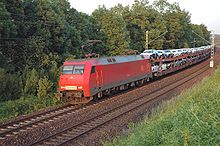Block train



A block train , also known as a block train , is a freight train that runs from the start to the destination station as a unit (same type of wagon, same consignor and recipient), possibly with organizational or operational stops. As a result, block train traffic is faster and cheaper than single wagon traffic . The railways can thereby its system advantages over the lorry partly to and inland to express. Rail Cargo Groups (RCG) are by definition block train wagon groups that are posted at the same time, by one and the same consignor, in one and the same dispatch station, via one and the same transport route, to one and the same recipient, to one and the same destination station (according to the consignment note ) are.
Block trains run wherever large quantities of a load have to be transported ( bulk transport ). Block trains can usually be recognized optically by the fact that they are made up of wagons or loads of the same type, although the color may vary. The transport as a block train is an offer of the railway companies, which largely meets the requirements of a cost-optimized transport by minimizing on-the-way handling and makes optimal use of the advantages of the rail over other modes of transport. The avoidance of on-the-go treatments not only reduces the load on shunting and shunting stations (marshalling yards) and the associated cost reduction, it also minimizes the risk of damage.
use
The block train is typical for the transport of bulk goods such as gravel or crushed stone . In the mining industry , they are used specifically for the transport of:
- Ore from the port to the steel mill or from
- Coal from the port or the colliery to the power plant .
Liquid bulk goods such as chemicals are transported in block trains consisting of tank wagons , for example:
- Petroleum products from the refinery to the tank farm .
Block trains are also used for the transport of general cargo , for example from motor vehicles from the factory to the distribution warehouse or to the port of shipment .
Also containers - or Klv trains that travel directly from terminal to terminal, run like a block train.
designation
Trains were at the Deutsche Bahn earlier with the Zuggattungskürzel Gag refers to the current name is CT (English Complete Train ). However, not every block train is also a CT.
At the ÖBB the abbreviation GAG is still in use today. Empty car block trains are called LGAG, KLV block trains are called KGAG.
Individual evidence
- ↑ Annechristin Stein: The Wilthener schnapps train no longer runs (cannot be viewed without a (test) subscription. May 14, 2017.) The Wilthener schnapps train no longer runs. In: Saxon newspaper . October 8, 2009.
- ↑ name Schnapszug on www.bahnbilder.de
- ^ E. Jänsch (Ed.): Handbook Das System Bahn. 2008, ISBN 978-3-8715-4511-5 , p. 269 ff.
- ↑ ÖBB - Information Document Rail Production Systems 2015.
- ^ ÖBB Infra Betrieb AG: Timetable aid DB 639 . Ed .: ÖBB Produktion GmbH. Linz, Salzburg, Gmünd, Wörth June 2017.

